LOOKING FOR A PREVIOUS STORY? CHECK THE
ARCHIVE.
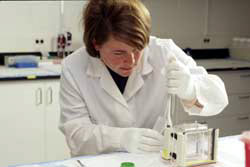
|
| Merckís U.S. Human Health Division will add the 800 new research positions in Upper Gwynedd, Pa. |
R&D Jobs in SE Pennsylvania
by JACK LYNE, Site Selection Executive Editor of Interactive Publishing
NORTH WALES, Pa. —
Merck & Co. has prescribed a strong growth
pill for its already formidable work-force cluster in Montgomery
County, Pa.: The pharmaceutical giant is adding 800 new research
positions in a two-stage, $200-million expansion, Margaret McGlynn,
president of Merckís U.S. Human Health Division (USHH), announced at
the divisionís administrative offices in New Wales, Pa.
“This investment demonstrates Merckís commitment to maintaining its presence in southeastern Pennsylvania,” said McGlynn. “It will allow Merck to operate more efficiently while providing additional space to support the development of the growing number of products in the companyís research pipeline.”
USHHís Pennsylvania expansion plan includes building a new 600,000-sq.-ft. (54,000-sq.-m.) headquarters. Merck will construct that facility on a 154-acre (62-hectare) site that itís buying in eastern Montgomery County in Lower Gwynedd Township, Pa., near Philadelphia.
USHH will begin building its new headquarters in mid-2005, completing the process in about two years, according to Merck officialsí estimates. When the new facility is finished, the divisionís operational base will relocate from its current location in Upper Gwynedd Township.
USHH will use its roomy new headquarters to consolidate all of its U.S. sales and marketing divisions, said McGlynn. Merck will relocate 1,600 existing sales and marketing positions to the new site, which the company says could later be expanded to accommodate up to 1 million sq. ft. (90,000 sq. m.) of space.
The divisional headquarters project lacked the very wide-ranging focus of Merckís high-profile search for its 300-employee, $300-million vaccine plant. The company looked at more than 100 sites in 16 states before picking Durham, N.C., as the plant location early this year. (For more details, see “North Carolinaís $36M Incentives Injection Catches Merckís $300M Vaccine Plant,” the January 2004
Incentives Deal of the Month.)
This time around, though, Merckís USHH division concentrated its search solely on southeast Pennsylvania, company officials said.
The Siemens unit will remain at the new headquarters site. Merck will tear down all of the facility except the space that SEA is now occupying. The company will then rebuild an entirely new facility in Lower Gwynedd, with Siemens leasing its current space.
But Upper Gwynedd, too, will be part of Merckís expansion: The township may be losing a headquarters to its neighbor, but itís gaining a very big infusion of high-end jobs.
Once USHH moves into its new headquarters in Lower Gwynedd, the Merck division will add 800 new positions in Upper Gwynedd. All of the jobs will be in R&D.
Those additions come on the heels of Merckís two other previously announced expansions in Upper Gwynedd. The company has already completed a new 350,000-sq.-ft. (31,500-sq.-m.) R&D operation at its West Point location, where it plans to add another 125,000 sq. ft. (11,250 sq. m.). And this fall, Merck will break ground on a 375,000-sq.-ft. (33,750-sq.-m.) expansion at its 400-acre (160-hectare) complex thatís known within the company as “Upper Gwynedd.”
Nonetheless, the news of 800 additional R&D jobs made for particularly good news for the area. Though Merckís other recently announced expansions are very big projects, those projects arenít expected to add any new local jobs.
Whatís more, the company announced in November of last year that it was cutting costs by laying off 4,400 workers — 7 percent of its worldwide labor force. The Whitehouse Station, N.J.-based company has struggled recently as its biggest-selling drugs have lost patent protection, opening the door to competition from price-cutting generic manufacturers. Merckís Zocor, a highly popular cholesterol fighter, has come off patent in many European markets, and it will lose its U.S. protection in 2006.
USHH is receiving a $1.25-million grant from the Pennsylvania Infrastructure Development Program and a $1-million award from the Opportunity Grant Program (which rewards job creation or preservation). In addition, Pennsylvania Department of Community and Economic Development officials said that the Merck division is getting $2.4 million in job-creation tax credits and $750,000 in job-training assistance.
“This commitment not only means 800 new jobs for the area,” said Gov. Ed Rendell (D). “It also paves the way for increased economic growth and activity, marking a new day for Montgomery County and the entire region.”
Merck employs some 14,000 workers in Pennsylvania. About 12,000 of those positions are in Montgomery County.
After Threatening Shutdown,
Agrium Moving Ahead
with $24M Alberta Expansion
by JACK LYNE, Site Selection
Executive Editor of Interactive Publishing
“This investment demonstrates Merckís commitment to maintaining its presence in southeastern Pennsylvania,” said McGlynn. “It will allow Merck to operate more efficiently while providing additional space to support the development of the growing number of products in the companyís research pipeline.”
USHHís Pennsylvania expansion plan includes building a new 600,000-sq.-ft. (54,000-sq.-m.) headquarters. Merck will construct that facility on a 154-acre (62-hectare) site that itís buying in eastern Montgomery County in Lower Gwynedd Township, Pa., near Philadelphia.
USHH will begin building its new headquarters in mid-2005, completing the process in about two years, according to Merck officialsí estimates. When the new facility is finished, the divisionís operational base will relocate from its current location in Upper Gwynedd Township.
USHH will use its roomy new headquarters to consolidate all of its U.S. sales and marketing divisions, said McGlynn. Merck will relocate 1,600 existing sales and marketing positions to the new site, which the company says could later be expanded to accommodate up to 1 million sq. ft. (90,000 sq. m.) of space.
The divisional headquarters project lacked the very wide-ranging focus of Merckís high-profile search for its 300-employee, $300-million vaccine plant. The company looked at more than 100 sites in 16 states before picking Durham, N.C., as the plant location early this year. (For more details, see “North Carolinaís $36M Incentives Injection Catches Merckís $300M Vaccine Plant,” the January 2004
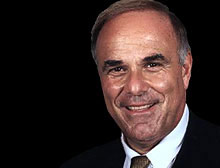
|
| Merckís expansion “marks a new day for Montgomery County and the entire region,” said Gov. Ed Rendell (pictured). |
This time around, though, Merckís USHH division concentrated its search solely on southeast Pennsylvania, company officials said.
Upper Gwynedd
Getting R&D Jobs
Merck will build the new USHH headquarters at a site that was once owned by Moore Products, a manufacturer of measurement and process control equipment. Siemens acquired Moore Products in 2002. Siemens Energy & Automation (SEA) is currently the lone occupant in the building, which Conshohocken-based Preferred Real Estate Investments acquired about a year ago.
Getting R&D Jobs
The Siemens unit will remain at the new headquarters site. Merck will tear down all of the facility except the space that SEA is now occupying. The company will then rebuild an entirely new facility in Lower Gwynedd, with Siemens leasing its current space.
But Upper Gwynedd, too, will be part of Merckís expansion: The township may be losing a headquarters to its neighbor, but itís gaining a very big infusion of high-end jobs.
Once USHH moves into its new headquarters in Lower Gwynedd, the Merck division will add 800 new positions in Upper Gwynedd. All of the jobs will be in R&D.
Those additions come on the heels of Merckís two other previously announced expansions in Upper Gwynedd. The company has already completed a new 350,000-sq.-ft. (31,500-sq.-m.) R&D operation at its West Point location, where it plans to add another 125,000 sq. ft. (11,250 sq. m.). And this fall, Merck will break ground on a 375,000-sq.-ft. (33,750-sq.-m.) expansion at its 400-acre (160-hectare) complex thatís known within the company as “Upper Gwynedd.”
Nonetheless, the news of 800 additional R&D jobs made for particularly good news for the area. Though Merckís other recently announced expansions are very big projects, those projects arenít expected to add any new local jobs.
Whatís more, the company announced in November of last year that it was cutting costs by laying off 4,400 workers — 7 percent of its worldwide labor force. The Whitehouse Station, N.J.-based company has struggled recently as its biggest-selling drugs have lost patent protection, opening the door to competition from price-cutting generic manufacturers. Merckís Zocor, a highly popular cholesterol fighter, has come off patent in many European markets, and it will lose its U.S. protection in 2006.
State Providing
Subsidies of $5.4 Million
The state is facilitating Merckís newest southeastern Pennsylvania expansion with a $5.4-million incentive package.
Subsidies of $5.4 Million

|
| Merck
already employs 14,000 workers in Pennsylvania, some of them
in this facility in Whiteland Business Park in the city of Exton.
Photo: C. E. Hough Associates |
USHH is receiving a $1.25-million grant from the Pennsylvania Infrastructure Development Program and a $1-million award from the Opportunity Grant Program (which rewards job creation or preservation). In addition, Pennsylvania Department of Community and Economic Development officials said that the Merck division is getting $2.4 million in job-creation tax credits and $750,000 in job-training assistance.
“This commitment not only means 800 new jobs for the area,” said Gov. Ed Rendell (D). “It also paves the way for increased economic growth and activity, marking a new day for Montgomery County and the entire region.”
Merck employs some 14,000 workers in Pennsylvania. About 12,000 of those positions are in Montgomery County.
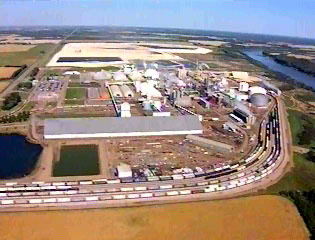
|
| Agriumís expansion will add 300 acres (120 hectares) to the gypsum pile area — in the process saving 400 jobs that wouldíve disappeared if the expansion hadnít been approved. |
Agrium Moving Ahead
with $24M Alberta Expansion
by JACK LYNE, Site Selection
Executive Editor of Interactive Publishing
CALGARY, Alberta — Agrium
Products wonít be shuttering Canadaís largest fertilizer plant
after all. After getting final provincial approval, the manufacturer
of agricultural nutrients and industrial products has decided instead
to move forward with an $18.3-mllion expansion of its phosphate fertilizer
operation in the Edmonton metro. (All
figures in Project Watch have been converted to U.S. dollars.)
At public hearings in February, Agrium announced that it would close the Alberta facility if its expansion didnít receive regulatory approval. The shutdown wouldíve put 400 employees out of work at the plant, located on the banks North Saskatchewan River about eight miles (13 kilometers) south of the city of Redwater.
But now that wonít be necessary. The Alberta Natural Resources Conservation Board (NRCB) gave the expansion “conditional approval” on Aug. 9 in Calgary.
“We are very pleased that the regulatory process has confirmed that our project is in the public interest, and we can now move forward with our extension,” said Alex Watson, general manager of Agriumís operations in Redwater and Saskatchewan.
With the NRCBís approval, a giant pile of gypsum will now get even bigger. Gypsum is a byproduct in phosphate fertilizer production.
Outside Agriumís so-called Redwater Plant,
surrounded by containment dikes, sits a gypsum pile thatís now approximately
99 feet (30 meters) tall and stretches out for some 430 acres (172
hectares). The gypsum from the plantís manufacturing is mixed with
water to form a slurry mixture thatís pumped into a pond, where the
solids settle out.
The companyís expansion plan calls for adding another 300 acres (120 hectares) to the pile area in order to add more cooling storage ponds. The existing ponds are at capacity and must be replaced, Agrium says.
The huge gypsum piles reflect the sizable capacity of the Redwater operation, which has hit record production levels for the last five years. The plant now turns out 682,000 tons (620,000 metric tons) of phosphate a year — along with some 1.87 tons (1.7 million metric tons) of gypsum.
The Redwater expansion faced stiff opposition from residents living near the facility. That neighborhood on the North Saskatchewan Riverís south bank is in an area that was rezoned for heavy industry three years ago. The edges of the river along that stretch are heavily industrialized. Air Liquide, Dow, Oxy Vinyl and Shell all have refineries across the river from the Redwater plant.
Residents near the Redwater plant pressured the NRCB for the public hearings in February on Agriumís expansion. They voiced a number of health-related concerns during those sessions, many of them related to the fluoride contained in gypsum. Fluoride emissions, they contended, were poisoning their water and making them — and their cattle — ill.
Noise and low-level radiation from the plant were also among prominent complaints. In addition, some neighboring residents said that the proximity of Agriumís plant was severely reducing their property values.
Agrium responded by pointing out that the new gypsum cooling ponds would actually be farther away from nearby residentsí homes than the existing ponds.
After a full environmental assessment, the NRCB gave the expansion
a clean bill of health — for the most part.
“Overall, the project is unlikely to result in significant adverse environmental effects, provided that the design specifications and mitigation measures proposed by Agrium and the recommendations and conditions of the panel are implemented,” the board said in its ruling.
Significantly, though, the board concluded that Agrium didnít have a full grasp of the plantís environmental issues.
“The panel does not believe that Agrium fully understands the source and impacts of fluoride emissions from the plant,” the ruling said.
Thatís where the NRCBís “conditions attached to the approval” come into play. The board is requiring the company “to undertake studies to improve its understanding of the factors contributing to fluoride emissions.” The boardís other conditions include demanding Agrium to develop “a credible procedure” for emission estimates and risk assessment and to “develop and implement a mitigation plan [for the existing gypsum stack] that is to [Alberta Environmental Protectionís] satisfaction.”
The board also answered another concern of the plantís neighbors, stressing “the need for Agrium to renew its commitment to resolve its neighborsí noise concerns.”
The company says that it doesnít “anticipate any difficulty in addressing” any of the boardís conditions.
“This decision contributes to the long-term viability of the facility,” said Watson. The approved plan will provide enough gypsum storage space to satisfy the Redwater plantís needs for 25 years, he added.
So Agrium is now definitely moving ahead with its expansion. And almost just as surely, neighborsí complaints will keep coming.
Michelinís $31M Nova Scotia
Expansion Draws Both Bouquets, Barbs
by JACK LYNE, Site Selection Executive Editor of Interactive Publishing
 PLEASE
VISIT OUR SPONSOR • CLICK ABOVE
PLEASE
VISIT OUR SPONSOR • CLICK ABOVE 
At public hearings in February, Agrium announced that it would close the Alberta facility if its expansion didnít receive regulatory approval. The shutdown wouldíve put 400 employees out of work at the plant, located on the banks North Saskatchewan River about eight miles (13 kilometers) south of the city of Redwater.
But now that wonít be necessary. The Alberta Natural Resources Conservation Board (NRCB) gave the expansion “conditional approval” on Aug. 9 in Calgary.
“We are very pleased that the regulatory process has confirmed that our project is in the public interest, and we can now move forward with our extension,” said Alex Watson, general manager of Agriumís operations in Redwater and Saskatchewan.
With the NRCBís approval, a giant pile of gypsum will now get even bigger. Gypsum is a byproduct in phosphate fertilizer production.
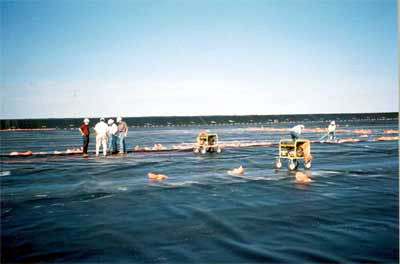
|
| The $24-million expansion will include building new cooling storage ponds for the gypsum thatís a byproduct of the Redwater plant. The ponds will have liners made of high-density polyethylene (pictured here during assembly at another Agrium plant). |
The companyís expansion plan calls for adding another 300 acres (120 hectares) to the pile area in order to add more cooling storage ponds. The existing ponds are at capacity and must be replaced, Agrium says.
The huge gypsum piles reflect the sizable capacity of the Redwater operation, which has hit record production levels for the last five years. The plant now turns out 682,000 tons (620,000 metric tons) of phosphate a year — along with some 1.87 tons (1.7 million metric tons) of gypsum.
Residents Cited
Health Concerns
The Redwater plant has been operating for 33 years. Calgary-based Agrium took over the plant in 1996 after it acquired rival firm Viridian. In addition to its Redwater and Saskatchewan operations, the company has two other Alberta plants in the cities of Carseland and Granum.
Health Concerns
The Redwater expansion faced stiff opposition from residents living near the facility. That neighborhood on the North Saskatchewan Riverís south bank is in an area that was rezoned for heavy industry three years ago. The edges of the river along that stretch are heavily industrialized. Air Liquide, Dow, Oxy Vinyl and Shell all have refineries across the river from the Redwater plant.
Residents near the Redwater plant pressured the NRCB for the public hearings in February on Agriumís expansion. They voiced a number of health-related concerns during those sessions, many of them related to the fluoride contained in gypsum. Fluoride emissions, they contended, were poisoning their water and making them — and their cattle — ill.
Noise and low-level radiation from the plant were also among prominent complaints. In addition, some neighboring residents said that the proximity of Agriumís plant was severely reducing their property values.
Agrium responded by pointing out that the new gypsum cooling ponds would actually be farther away from nearby residentsí homes than the existing ponds.
ĎConditions Attachedí to Approval

|
| Four of Agriumís 15 plants are in Alberta. In addition to its Redwater operation, the company has production facilities in Carseland, Granum and Saskatchewan (pictured). |
“Overall, the project is unlikely to result in significant adverse environmental effects, provided that the design specifications and mitigation measures proposed by Agrium and the recommendations and conditions of the panel are implemented,” the board said in its ruling.
Significantly, though, the board concluded that Agrium didnít have a full grasp of the plantís environmental issues.
“The panel does not believe that Agrium fully understands the source and impacts of fluoride emissions from the plant,” the ruling said.
Thatís where the NRCBís “conditions attached to the approval” come into play. The board is requiring the company “to undertake studies to improve its understanding of the factors contributing to fluoride emissions.” The boardís other conditions include demanding Agrium to develop “a credible procedure” for emission estimates and risk assessment and to “develop and implement a mitigation plan [for the existing gypsum stack] that is to [Alberta Environmental Protectionís] satisfaction.”
The board also answered another concern of the plantís neighbors, stressing “the need for Agrium to renew its commitment to resolve its neighborsí noise concerns.”
The company says that it doesnít “anticipate any difficulty in addressing” any of the boardís conditions.
“This decision contributes to the long-term viability of the facility,” said Watson. The approved plan will provide enough gypsum storage space to satisfy the Redwater plantís needs for 25 years, he added.
So Agrium is now definitely moving ahead with its expansion. And almost just as surely, neighborsí complaints will keep coming.
 |
Expansion Draws Both Bouquets, Barbs
by JACK LYNE, Site Selection Executive Editor of Interactive Publishing
HALIFAX, Nova Scotia —
Michelinís plan to invest some $31 million
in two of its existing plants in Nova Scotia
certainly looks like very good news for the provinceís
economy. Nonetheless, the incentives connected to the project have
rapidly turned the expansions into a political football.
Michelin will invest $19 million in its plant in Bridgewater and another $12 million in its plant in Waterville, the French-based tire manufacturer announced in Halifax on Aug. 3rd. Both investments will be focused on equipment upgrades. With the new equipment, both plants will begin making larger dimension tires for light trucks, Michelin officials said. The new equipment will also give the operations greater flexibility in manufacturing output.
The upgrades will be coming to two very large operations. Bridgewater operation has some 1,100 employees, while the Waterville plant has about 1,000. And Michelin employs about 1,250 more Nova Scotians at its plant in Granton.
All three plants are major economic cornerstones in the small towns in which theyíre located. Bridgewater has some 8,000 residents, while Granton has about 6,500, and Waterville has some 15,000.
“More than three thousand Nova Scotians and their families depend on Michelin for their livelihoods,” Nova Scotia Economic Development Minister Ernest Fage said at the expansionsí announcement. “This [incentives] contribution will help secure those jobs, as well as expanding the existing work force.”
Michelin North America General Counsel and Secretary George Sutherland characterized the expansions as a strong endorsement of the plantsí performance.
“These investments demonstrate the ability of Nova Scotia employees to deliver on quality and price in a very competitive market,” Sutherland noted. “They are good news for our Bridgewater and Waterville facilities.”
The NDPís criticism is centered on Nova Scotiaís $3 million in incentives for the two Michelin expansions. Those subsidies, as the NDP has repeatedly pointed out, are not tied to job creation.
And thatís left Hamm in an uncomfortable spot. De-emphasizing incentives that werenít tied to job creation was one of Hammís campaign promises in 1999, during his first successful run for Nova Scotiaís top governmental job.
In addition, Michelinís new subsidies come after the current government had already written off about $35.5 million in loans to the tire-maker. Those loans were converted to grants, though, only after Michelin met its targets for job creation and capital investment.
“Grants and loan write-offs continue to go out to businesses like Michelin that are already profitable,” Epstein charged. The only acceptable subsidies for corporate expansions, he maintained, are payroll rebates directly linked to newly created jobs.
Bowing to Competitive Realities
The Hamm government has countered that Michelinís incentives are
linked to the creation of jobs — albeit not a lot of them.
The company must create at least 56 new positions to receive the
full $3 million in subsidies, Fage said. But Michelin will still
receive a substantial part of the incentives if it doesnít create
any jobs.
The company hasnít ever mentioned job creation as part of the projects. Michelin officials have estimated that the expansions may add from 16 to 24 new jobs at each plant. But the company isnít guaranteeing that either project will result in any new jobs.
What appears to have happened is that the Hamm government realized that the realities of global competition often trump voter-friendly campaign pledges.
With the new equipment, the Bridgewater and Waterville plants will be able to begin making the kind of tires used on sport utility vehicles — a hot-selling commodity in todayís market. And having that added ability, Hamm has apparently grasped, makes the future much more solid for those plants — and for their sizable Nova Scotian work forces.
“Given that Michelinís plants must compete internationally for investment capital,” said Fage, “weíre proving that Nova Scotia can successfully compete on the global market. Without incentives to compete for these upgrades, the projects wouldíve gone elsewhere.”
Michelinís Sutherland sounded a similar note.
“Michelin and our Nova Scotia plants compete on a global basis with tire companies that manufacture throughout the world,” Sutherland said. “We very much appreciate the provinceís recognition of this.”
†Fage also maintained that Michelinís subsidies were congruent with the Hamm administrationís policy.
“This investment in the economies of the Annapolis Valley and South Shore reflects the priority that our growth strategy, Opportunities for Prosperity, puts on strengthening our rural economies,” he said.
Michelin wonít start getting any of its Nova Scotia incentives until the new equipment has been added and both plants are using it in commercial production. The company is projecting that equipment installation will begin in May of 2005, with production beginning in September of 2005.
Michelin will invest $19 million in its plant in Bridgewater and another $12 million in its plant in Waterville, the French-based tire manufacturer announced in Halifax on Aug. 3rd. Both investments will be focused on equipment upgrades. With the new equipment, both plants will begin making larger dimension tires for light trucks, Michelin officials said. The new equipment will also give the operations greater flexibility in manufacturing output.
The upgrades will be coming to two very large operations. Bridgewater operation has some 1,100 employees, while the Waterville plant has about 1,000. And Michelin employs about 1,250 more Nova Scotians at its plant in Granton.
All three plants are major economic cornerstones in the small towns in which theyíre located. Bridgewater has some 8,000 residents, while Granton has about 6,500, and Waterville has some 15,000.
“More than three thousand Nova Scotians and their families depend on Michelin for their livelihoods,” Nova Scotia Economic Development Minister Ernest Fage said at the expansionsí announcement. “This [incentives] contribution will help secure those jobs, as well as expanding the existing work force.”
Michelin North America General Counsel and Secretary George Sutherland characterized the expansions as a strong endorsement of the plantsí performance.
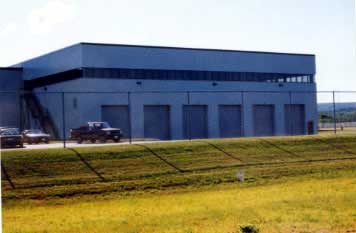
|
| Michelinís will make $12 million of its Nova Scotian investment in its plant in Waterville (pictured), which employs about 1,000 workers. |
“These investments demonstrate the ability of Nova Scotia employees to deliver on quality and price in a very competitive market,” Sutherland noted. “They are good news for our Bridgewater and Waterville facilities.”
Incentives: Thatís the Rub
Not so fast, countered critics from the New Democratic Party, which
opposes Nova Scotia Premier John Hammís current Tory Party administration.
The provinceís agreement with Michelin amounted to “a scandal,”
charged Nova Scotia Legislative Assembly member Howard Epstein,
a frequent NDP commentator on economic development. The NDPís criticism is centered on Nova Scotiaís $3 million in incentives for the two Michelin expansions. Those subsidies, as the NDP has repeatedly pointed out, are not tied to job creation.
And thatís left Hamm in an uncomfortable spot. De-emphasizing incentives that werenít tied to job creation was one of Hammís campaign promises in 1999, during his first successful run for Nova Scotiaís top governmental job.
In addition, Michelinís new subsidies come after the current government had already written off about $35.5 million in loans to the tire-maker. Those loans were converted to grants, though, only after Michelin met its targets for job creation and capital investment.
“Grants and loan write-offs continue to go out to businesses like Michelin that are already profitable,” Epstein charged. The only acceptable subsidies for corporate expansions, he maintained, are payroll rebates directly linked to newly created jobs.
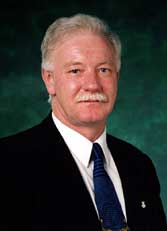
|
| “Given that Michelinís plants must compete internationally for investment capital,” said Nova Scotia Economic Development Minister Ernest Fage (pictured), “weíre proving that Nova Scotia can successfully compete on the global market. |
The company hasnít ever mentioned job creation as part of the projects. Michelin officials have estimated that the expansions may add from 16 to 24 new jobs at each plant. But the company isnít guaranteeing that either project will result in any new jobs.
What appears to have happened is that the Hamm government realized that the realities of global competition often trump voter-friendly campaign pledges.
With the new equipment, the Bridgewater and Waterville plants will be able to begin making the kind of tires used on sport utility vehicles — a hot-selling commodity in todayís market. And having that added ability, Hamm has apparently grasped, makes the future much more solid for those plants — and for their sizable Nova Scotian work forces.
“Given that Michelinís plants must compete internationally for investment capital,” said Fage, “weíre proving that Nova Scotia can successfully compete on the global market. Without incentives to compete for these upgrades, the projects wouldíve gone elsewhere.”
Michelinís Sutherland sounded a similar note.
“Michelin and our Nova Scotia plants compete on a global basis with tire companies that manufacture throughout the world,” Sutherland said. “We very much appreciate the provinceís recognition of this.”
†Fage also maintained that Michelinís subsidies were congruent with the Hamm administrationís policy.
“This investment in the economies of the Annapolis Valley and South Shore reflects the priority that our growth strategy, Opportunities for Prosperity, puts on strengthening our rural economies,” he said.
Michelin wonít start getting any of its Nova Scotia incentives until the new equipment has been added and both plants are using it in commercial production. The company is projecting that equipment installation will begin in May of 2005, with production beginning in September of 2005.
| CONTINUE TO THE LATEST EDITION OF “TOP INCENTIVES DEAL” | |
| RETURN TO: SITESELECTION.COM
|
LOOKING FOR A PREVIOUS
STORY? CHECK THE ARCHIVE.
|
 PLEASE
VISIT OUR SPONSOR • CLICK ABOVE
PLEASE
VISIT OUR SPONSOR • CLICK ABOVE 
©2004 Conway Data, Inc. All
rights reserved. Data is from many sources and is not warranted
to be accurate or current.